Perovskite Nano-Powder and Nano-Film Catalysts in Mineralization of Aqueous Organic Contaminants through Solar Simulated Radiation
Abstract
1. Introduction
2. Materials and Methods
2.1. Starting Materials
2.2. Equipment
2.3. Perovskite Powder Preparation
2.4. Perovskite Film Preparation
2.5. Photocatalytic Experiments
2.6. Control and Confirmation Experiments
3. Results and Discussion
3.1. Characterization Results
- Emission spectra:
- Electronic absorption spectra:
- Surface morphology and SEM micrographs:
- XRD structural study:
- XPS study:
- Specific surface area (SSA):
3.2. Contaminant Photodegradation Studies
- Control and confirmation results:
- Effect of pH:
- Effect of contaminant concentration:
- Continuous flow study:
- Catalyst recovery and reuse:
- Mechanism:
- Excitation of the semiconductor catalyst, shown in Equation (1), is a necessary step, which yields the excited Cat*.Cat + hv → Cat*
- The excited electrons travel to the conduction band (CBe−), leaving holes in the valence band (VBh+). The CBe− interacts with dissolved oxygen molecules to yield the highly reactive superoxide O2−• species. The superoxide may either oxidize the methylene blue (MB) or react with H+ ions to produce the reactive OH• radical, which in turn oxidizes the contaminant, as shown in Equations (2)–(5).CBe− + O2 → O2−•O2− + MB → Mineral productsO2− + H+ → OH•OH• + MB → Mineral products
- On the other hand, the VBh+ oxidizes water molecules to yield H+ and OH• radicals. The H+ reacts, yielding the reactive OH• radical which may oxidize the contaminants, as shown in Equation (6).VBh+ + H2O → H+ + OH•
4. Conclusions
Supplementary Materials
Author Contributions
Funding
Data Availability Statement
Acknowledgments
Conflicts of Interest
References
- Warren-Vega, W.M.; Campos-Rodríguez, A.; Zárate-Guzmán, A.I.; Romero-Cano, L.A. A current review of water pollutants in american continent: Trends and perspectives in detection, health risks, and treatment technologies. Int. J. Environ. Res. Public Health 2023, 20, 4499. [Google Scholar] [CrossRef] [PubMed]
- Tahir, H.; Saad, M.; Attala, O.A.; El-Saoud, W.A.; Attia, K.A.; Jabeen, S.; Zeb, J. Sustainable Synthesis of Iron–Zinc Nanocomposites by Azadirachta indica Leaves Extract for RSM-Optimized Sono-Adsorptive Removal of Crystal Violet Dye. Materials 2023, 16, 1023. [Google Scholar] [CrossRef]
- Saad, M.; Tahir, H.; Mustafa, S.; Attala, O.A.; El-Saoud, W.A.; Attia, K.A.; Filfilan, W.M.; Zeb, J. Polyvinyl Alcohol Assisted Iron–Zinc Nanocomposite for Enhanced Optimized Rapid Removal of Malachite Green Dye. Nanomaterials 2023, 13, 1747. [Google Scholar] [CrossRef] [PubMed]
- Zwiener, C.; Richardson, S.D.; De Marini, D.M.; Grummt, T.; Glauner, T.; Frimmel, F.H. Drowning in disinfection byproducts? Assessing swimming pool water. Environ. Sci. Technol. 2007, 41, 363–372. [Google Scholar] [CrossRef]
- Sadegh, H.; Ali, G.A. Potential applications of nanomaterials in wastewater treatment: Nanoadsorbents performance. In Research Anthology on Synthesis, Characterization, and Applications of Nanomaterials; IGI Global: Pennsylvania, PA, USA, 2021; pp. 1230–1240. [Google Scholar]
- Kaur, K.; Badru, R.; Singh, P.P.; Kaushal, S. Photodegradation of organic pollutants using heterojunctions: A review. J. Environ. Chem. Eng. 2020, 8, 103666. [Google Scholar]
- El Sharkawy, H.M.; Shawky, A.M.; Elshypany, R.; Selim, H. Efficient photocatalytic degradation of organic pollutants over TiO2 nanoparticles modified with nitrogen and MoS2 under visible light irradiation. Sci. Rep. 2023, 13, 8845. [Google Scholar] [CrossRef]
- Zyoud, A.H.; Zaatar, N.; Saadeddin, I.; Ali, C.; Park, D.; Campet, G.; Hilal, H.S. CdS-sensitized TiO2 in phenazopyridine photo-degradation: Catalyst efficiency, stability and feasibility assessment. J. Hazard. Mater. 2010, 173, 318–325. [Google Scholar] [CrossRef] [PubMed]
- Portier, J.; Hilal, H.; Saadeddin, I.; Hwang, S.; Subramanian, M.; Campet, G. Thermodynamic correlations and band gap calculations in metal oxides. Prog. Solid State Chem. 2004, 32, 207–217. [Google Scholar] [CrossRef]
- Elhadidy, M.; Abdel-Nabi, D.; Kruss, P. Ultraviolet solar radiation at Dhahran, Saudi Arabia. Sol. Energy 1990, 44, 315–319. [Google Scholar] [CrossRef]
- Rodrigues, A.S.; Silveira, J.E.; Carbajo, J.; Zazo, J.A.; Casas, J.A.; Fernandes, A.; Pacheco, M.J.; Ciríaco, L.; Lopes, A. Diclofenac photodegradation with the Perovskites BaFeyTi1−yO3 as catalysts. Environ. Sci. Pollut. Res. 2021, 28, 23822–23832. [Google Scholar] [CrossRef]
- Andronic, L.; Duta, A. The influence of TiO2 powder and film on the photodegradation of methyl orange. Mater. Chem. Phys. 2008, 112, 1078–1082. [Google Scholar] [CrossRef]
- Dewia, H.A.; Fangben Mengb, B.S.; Guoa, C.; Norlingc, B.; Chenb, X.; Lima, S. Investigation on Electron Transfer from Isolated Spinach Thylakoids to Indium Tin Oxide. RSC Adv. 2014, 4, 48815–48820. [Google Scholar] [CrossRef]
- Nkwachukwu, O.V.; Arotiba, O.A. Perovskite oxide–based materials for photocatalytic and photoelectrocatalytic treatment of water. Front. Chem. 2021, 9, 634630. [Google Scholar] [CrossRef]
- Faraj, Y.; Xie, R. Perovskite-Based Nanomaterials and Nanocomposites for Photocatalytic Decontamination of Water; IntechOpen: London, UK, 2022. [Google Scholar] [CrossRef]
- Brahmi, C.; Benltifa, M.; Vaulot, C.; Michelin, L.; Dumur, F.; Airoudj, A.; Morlet-Savary, F.; Raveau, B.; Bousselmi, L.; Lalevée, J. New hybrid perovskites/polymer composites for the photodegradation of organic dyes. Eur. Polym. J. 2021, 157, 110641. [Google Scholar] [CrossRef]
- Singh, H.; Rajput, J.K. Novel perovskite nanocatalyst (BiFeO3) for the photodegradation of rhodamine B/tartrazine and swift reduction of nitro compounds. J. Iran. Chem. Soc. 2019, 16, 2409–2432. [Google Scholar] [CrossRef]
- Chen, W.-Y.; Wang, C.-P.; Chen, P.-C.; Lin, K.-Y.A.; Ghosh, S.; Huang, C.-W.; Nguyen, V.-H. Perovskite zinc titanate photocatalysts synthesized by the sol–gel method and their application in the photocatalytic degradation of emerging contaminants. Catalysts 2021, 11, 854. [Google Scholar] [CrossRef]
- Tavakoli-Azar, T.; Mahjoub, A.R.; Sadjadi, M.S.; Farhadyar, N.; Sadr, M.H. Improving the photocatalytic performance of a perovskite ZnTiO3 through ZnTiO3@S nanocomposites for degradation of Crystal violet and Rhodamine B pollutants under sunlight. Inorg. Chem. Commun. 2020, 119, 108091. [Google Scholar] [CrossRef]
- Alkaykh, S.; Mbarek, A.; Ali-Shattle, E.E. Photocatalytic degradation of methylene blue dye in aqueous solution by MnTiO3 nanoparticles under sunlight irradiation. Heliyon 2020, 6, e03663. [Google Scholar] [CrossRef]
- Khan, I.; Saeed, K.; Zekker, I.; Zhang, B.; Hendi, A.H.; Ahmad, A.; Ahmad, S.; Zada, N.; Ahmad, H.; Shah, L.A. Review on methylene blue: Its properties, uses, toxicity and photodegradation. Water 2022, 14, 242. [Google Scholar] [CrossRef]
- Bharti, V.; Vikrant, K.; Goswami, M.; Tiwari, H.; Sonwani, R.K.; Lee, J.; Tsang, D.C.; Kim, K.-H.; Saeed, M.; Kumar, S. Biodegradation of methylene blue dye in a batch and continuous mode using biochar as packing media. Environ. Res. 2019, 171, 356–364. [Google Scholar] [CrossRef]
- Xu, J.Z.; Dai, L.; Wu, B.; Ding, T.; Zhu, J.J.; Lin, H.; Chen, H.L.; Shen, C.Y.; Jiang, Y. Determination of methylene blue residues in aquatic products by liquid chromatography-tandem mass spectrometry. J. Sep. Sci. 2009, 32, 4193–4199. [Google Scholar] [CrossRef]
- Dunicz, B.L. Surface area of activated charcoal by Langmuir adsorption isotherm. J. Chem. Educ. 1961, 38, 357. [Google Scholar] [CrossRef]
- Rheima, A.M.; Aboud, N.; Jasim, B.E.; Ismail, A.H.; Abbas, Z.S. Synthesis and structural characterization of ZnTiO3 nanoparticles via modification sol-gel prosses for assessment of their antimicrobial activity. Int. J. Pharm. Res. 2021, 13, 342–347. [Google Scholar]
- Frederichi, D.; Scaliante, M.H.N.O.; Bergamasco, R. Structured photocatalytic systems: Photocatalytic coatings on low-cost structures for treatment of water contaminated with micropollutants—A short review. Environ. Sci. Pollut. Res. 2021, 28, 23610–23633. [Google Scholar] [CrossRef] [PubMed]
- Kurra, N.; Jenjeti, R.N. Micro-electrochemical capacitors: Progress and future status. J. Energy Storage 2022, 55, 105702. [Google Scholar] [CrossRef]
- Chang, H.; Cho, K.-C.; Chen, T.-L.; Chu, K.-H.; Jiang, L.-J. Preparation and characterization of anthocyanin dye and counter electrode thin film with carbon nanotubes for dye-sensitized solar cells. Mater. Trans. 2011, 52, 1977–1982. [Google Scholar] [CrossRef]
- Cenens, J.; Schoonheydt, R. Visible spectroscopy of methylene blue on hectorite, laponite B, and barasym in aqueous suspension. Clays Clay Miner. 1988, 36, 214–224. [Google Scholar] [CrossRef]
- Nassar, H.; Zyoud, A.; Helal, H.H.; Ghannam, H.; Kim, T.W.; Helal, M.H.; Hilal, H.S. Fluorine tin oxide-supported copper nanofilms as effective and selective de-nitration electrocatalysts. J. Electroanal. Chem. 2022, 911, 116249. [Google Scholar] [CrossRef]
- Arin, J.; Thongtem, S.; Phuruangrat, A.; Thongtem, T. Characterization of ZnO–TiO2 and zinc titanate nanoparticles synthesized by hydrothermal process. Res. Chem. Intermed. 2017, 43, 3183–3195. [Google Scholar] [CrossRef]
- Enhessari, M.; Parviz, A.; Karamali, E.; Ozaee, K. Synthesis, characterisation and optical properties of MnTiO3 nanopowders. J. Exp. Nanosci. 2012, 7, 327–335. [Google Scholar] [CrossRef]
- Acosta-Silva, Y.; Castanedo-Perez, R.; Torres-Delgado, G.; Méndez-López, A.; Zelaya-Angel, O. Analysis of the photocatalytic activity of CdS+ ZnTiO3 nanocomposite films prepared by sputtering process. Superlattices Microstruct. 2016, 100, 148–157. [Google Scholar] [CrossRef]
- Zhang, P.; Shao, C.; Zhang, M.; Guo, Z.; Mu, J.; Zhang, Z.; Zhang, X.; Liu, Y. Bi2MoO6 ultrathin nanosheets on ZnTiO3 nanofibers: A 3D open hierarchical heterostructures synergistic system with enhanced visible-light-driven photocatalytic activity. J. Hazard. Mater. 2012, 217, 422–428. [Google Scholar] [CrossRef]
- Reddy, K.H.; Martha, S.; Parida, K.M. Fabrication of BiOI/n-ZnTiO3 heterojunction for degradation of rhodamine under under 6G visible light irradiation. Inorg. Chem. 2013, 52, 6390r401. [Google Scholar] [CrossRef]
- Gao, Z.; Qu, X. Construction of ZnTiO3/Bi4NbO8Cl heterojunction with enhanced photocatalytic performance. Nanoscale Res. Lett. 2020, 15, 64. [Google Scholar] [CrossRef] [PubMed]
- Cai, Y.; Ye, Y.; Tian, Z.; Liu, J.; Liu, Y.; Liang, C. In situ growth of lamellar ZnTiO3 nanosheets on TiO2 tubular array with enhanced photocatalytic activity. Phys. Chem. Chem. Phys. 2013, 15, 20203–20209. [Google Scholar] [CrossRef]
- Raveendra, R.; Prashanth, P.; Hari Krishna, R.; Bhagya, N.; Sathyanarayani, S.; Na-gabhushana, B. Carbothermal synthesis and photoluminescence characteristics of pure undoped ZnTiO3 nanocrystals. J. Adv. Phys. Sci 2016, 6, 4–7. [Google Scholar]
- Kanhere, P.; Chen, Z. A review on visible light active perovskite-based photocatalysts. Molecules 2014, 19, 19995–20022. [Google Scholar] [CrossRef] [PubMed]
- Wang, C.-L.; Hwang, W.-S.; Chang, K.-M.; Ko, H.-H.; Hsi, C.-S.; Huang, H.-H.; Wang, M.-C. Formation and morphology of Zn2Ti3O8 powders using hydrothermal process without dispersant agent or mineralizer. Int. J. Mol. Sci. 2011, 12, 935–945. [Google Scholar] [CrossRef]
- John, A.K.; Palaty, S.; Sharma, S.S. Greener approach towards the synthesis of titanium dioxide nanostructures with exposed {001} facets for enhanced visible light photodegradation of organic pollutants. J. Mater. Sci. Mater. Electron. 2020, 31, 20868–20882. [Google Scholar] [CrossRef]
- Kitchamsetti, N.; Didwal, P.N.; Mulani, S.R.; Patil, M.S.; Devan, R.S. Photocatalytic activity of MnTiO3 perovskite nanodiscs for the removal of organic pollutants. Heliyon 2021, 7, e07297. [Google Scholar] [CrossRef]
- Alwany, A.B.; Youssef, G.; Samir, O.; Algradee, M.A.; Yahya, N.A.A.; Swillam, M.A.; Humaidi, S.; Abd-Shukor, R. Annealing temperature effects on the size and band gap of ZnS quantum dots fabricated by co-precipitation technique without capping agent. Sci. Rep. 2023, 13, 10314. [Google Scholar] [CrossRef] [PubMed]
- Zyoud, A.; Nassar, I.; Salman, M.; Iwissat, S.; Zyoud, S.; Helal, M.; Kim, T.; Rahil, M.; Abuamsha, R.; Shahin, N. Nano-ZnO film photocatalysts in bench-scale continuous-flow mineralization of olive mill waste contaminants in water. Int. J. Environ. Sci. Technol. 2021, 19, 4379–4392. [Google Scholar] [CrossRef]
- Sbeah, M.; Zyoud, A.; Ishteiwi, M.; Hajjyahya, M.; Al Armouzi, N.; Qamhieh, N.; Hajamohideen, A.R.; Zyoud, S.; Helal, H.H.; Bsharat, H. Assessment of flexible pristine CdS film electrodes in photoelectrochemical light-to-electricity conversions. Mater. Chem. Phys. 2023, 293, 126967. [Google Scholar] [CrossRef]
- Tang, M.; Lu, S.; He, L.; Zhu, X.; Feng, W.; Zhang, W. Preparation, Characterization of ZnTiO3/ZnO Composite Materials and Their Photocatalytic Performance. Nanomaterials 2022, 12, 1345. [Google Scholar] [CrossRef]
- Glasstone, S.; Lewis, D. Elements of Physical Chemistry, 2nd ed.; Macmilan Press Ltd.: Mumbai, India, 1983; p. 566. [Google Scholar]
- Richard, P.; Marilyn, K. Applied Colloid and Surface Chemistry; Wiley: New York, NY, USA, 2022; p. 51. [Google Scholar]
- The Agency for Toxic Substances and Disease Registry (ATDSR). Environmental Health and Medicine Education; The Agency for Toxic Substances and Disease Registry: Atlanta, GA, USA, 2018; pp. 1385–1565.
- Miranda, L.D.; Bellato, C.R.; Fontes, M.P.; de Almeida, M.F.; Milagres, J.L.; Minim, L.A. Preparation and evaluation of hydrotalcite-iron oxide magnetic organocomposite intercalated with surfactants for cationic methylene blue dye removal. Chem. Eng. J. 2014, 254, 88–97. [Google Scholar] [CrossRef]
- Jaramillo-Fierro, X.; Alvarado, H.; Montesdeoca, F.; Valarezo, E. Faujasite-Type Zeolite Obtained from Ecuadorian Clay as a Support of ZnTiO3/TiO2 NPs for Cyanide Removal in Aqueous Solutions. Int. J. Mol. Sci. 2023, 24, 9281. [Google Scholar] [CrossRef]
- Jaramillo-Fierro, X.; Cuenca, G.; Ramón, J. Comparative Study of the Effect of Doping ZnTiO3 with Rare Earths (La and Ce) on the Adsorption and Photodegradation of Cyanide in Aqueous Systems. Int. J. Mol. Sci. 2023, 24, 3780. [Google Scholar] [CrossRef]
- Bae, K.-N.; Noh, S.I.; Ahn, H.-J.; Seong, T.-Y. Effect of MnTiO3 surface treatment on the performance of dye-sensitized solar cells. Mater. Lett. 2013, 96, 67–70. [Google Scholar] [CrossRef]
- Zyoud, A.; Zyoud, A.H.; Zyoud, S.H.; Nassar, H.; Zyoud, S.H.; Qamhieh, N.; Hajamohideen, A.; Hilal, H.S. Photocatalytic degradation of aqueous methylene blue using ca-alginate supported ZnO nanoparticles: Point of zero charge role in adsorption and photodegradation. Environ. Sci. Pollut. Res. 2023, 30, 68435–68449. [Google Scholar] [CrossRef]
- Petrovičová, B.; Dahrouch, Z.; Triolo, C.; Pantò, F.; Malara, A.; Patanè, S.; Allegrini, M.; Santangelo, S. Photocatalytic degradation of methylene blue dye by electrospun binary and ternary zinc and titanium oxide nanofibers. Appl. Sci. 2021, 11, 9720. [Google Scholar] [CrossRef]
- Jaramillo Fierro, X.V. Synthesis, Characterization and Theoretical Calculations of ZnTiO3 for the Adsorption and Photocatalytic Removal of Methylene Blue Dye. Ph.D. Thesis, Universitat Rovira i Virgili, Tarragona, Spain, 2022. Available online: http://hdl.handle.net/10803/674398 (accessed on 4 August 2023).
- The pH of Water: What to Know. Available online: https://www.medicalnewstoday.com/articles/327185 (accessed on 7 July 2023).
- Utami, F.; Rahman, D.; Margareta, D.; Rahmayanti, H.; Munir, R.; Sustini, E.; Abdullah, M. TiO2 photocatalytic degradation of methylene blue using simple spray method. In Proceedings of the IOP Conference Series: Materials Science and Engineering, Kazimierz Dolny, Poland, 21–23 November 2019; IOP Publishing: Bristol, UK, 2019; Volume 599, p. 012026. [Google Scholar] [CrossRef]
- Komaraiah, D.; Madhukar, P.; Vijayakumar, Y.; Reddy, M.R.; Sayanna, R. Photocatalytic degradation study of methylene blue by brookite TiO2 thin film under visible light irradiation. Mater. Today Proc. 2016, 3, 3770–3778. [Google Scholar] [CrossRef]
- Yogi, C.; Kojima, K.; Wada, N.; Tokumoto, H.; Takai, T.; Mizoguchi, T.; Tamiaki, H. Photocatalytic degradation of methylene blue by TiO2 film and Au particles-TiO2 composite film. Thin Solid Film. 2008, 516, 5881–5884. [Google Scholar] [CrossRef]
- Wang, X.-Q.; Han, S.-F.; Zhang, Q.-W.; Zhang, N.; Zhao, D.-D. Photocatalytic oxidation degradation mechanism study of methylene blue dye waste water with GR/iTO2. MATEC Web Conf. 2018, 238, 03006. [Google Scholar] [CrossRef]
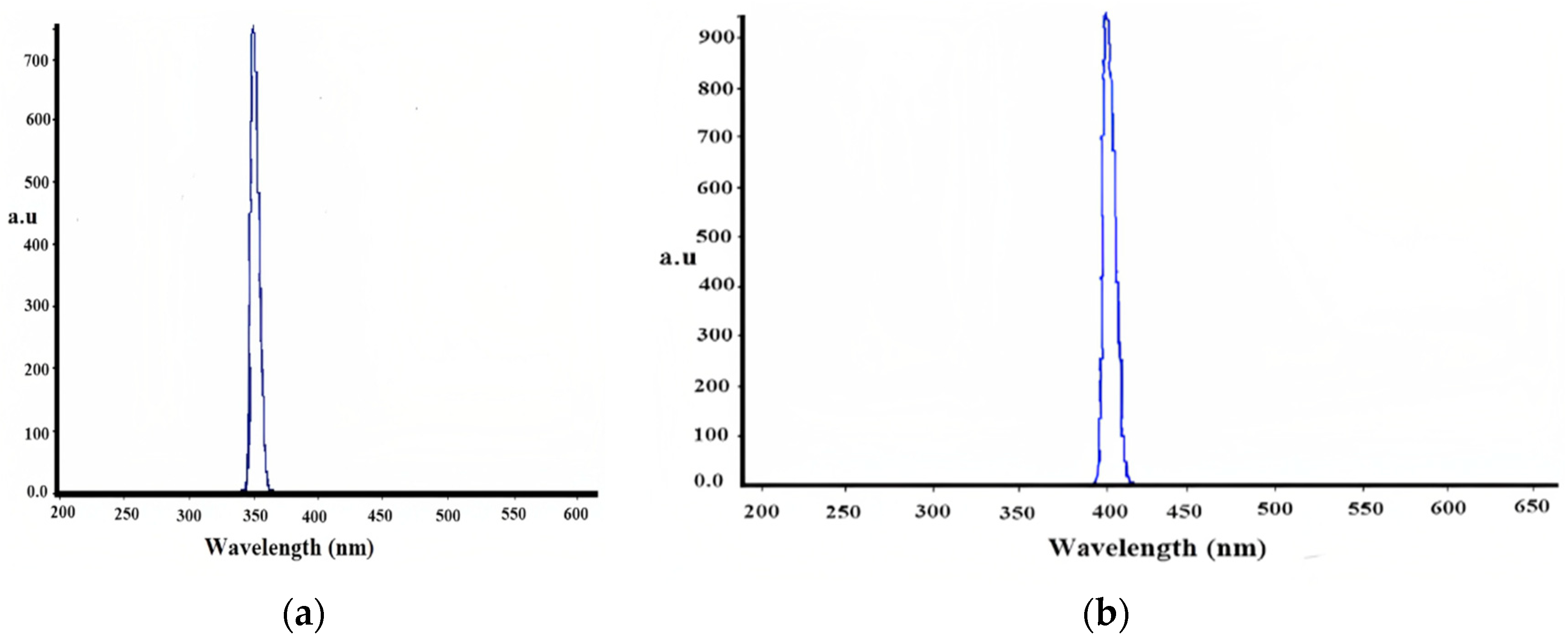

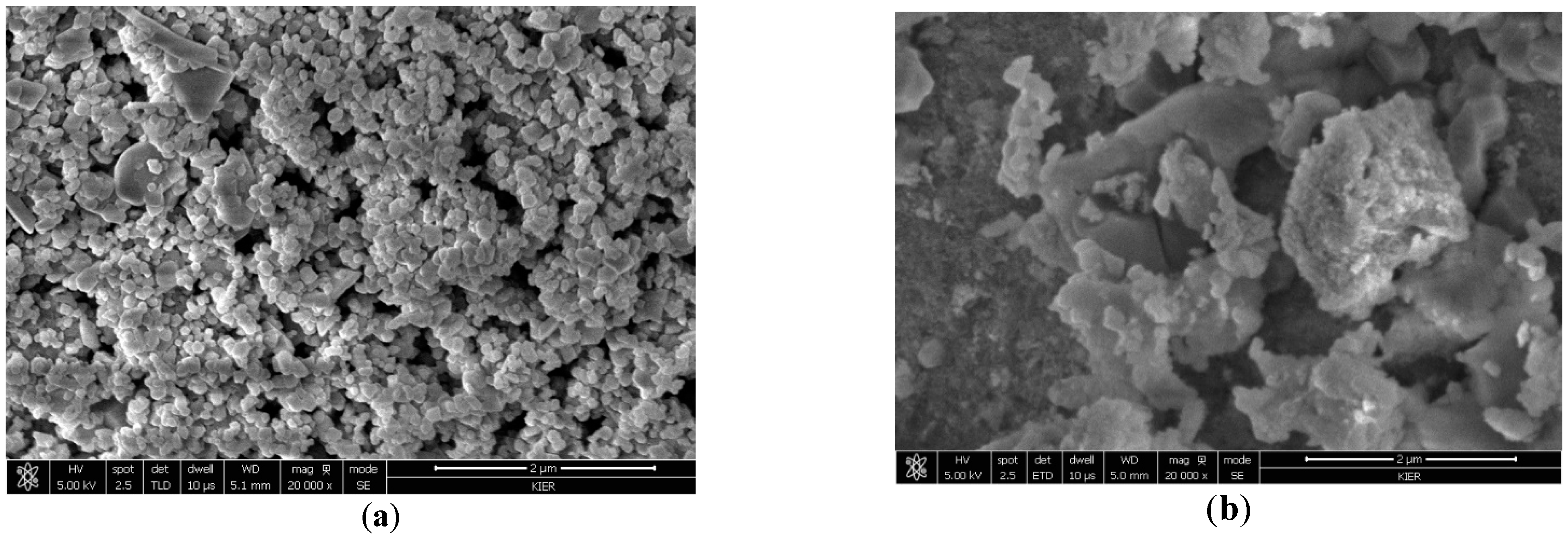
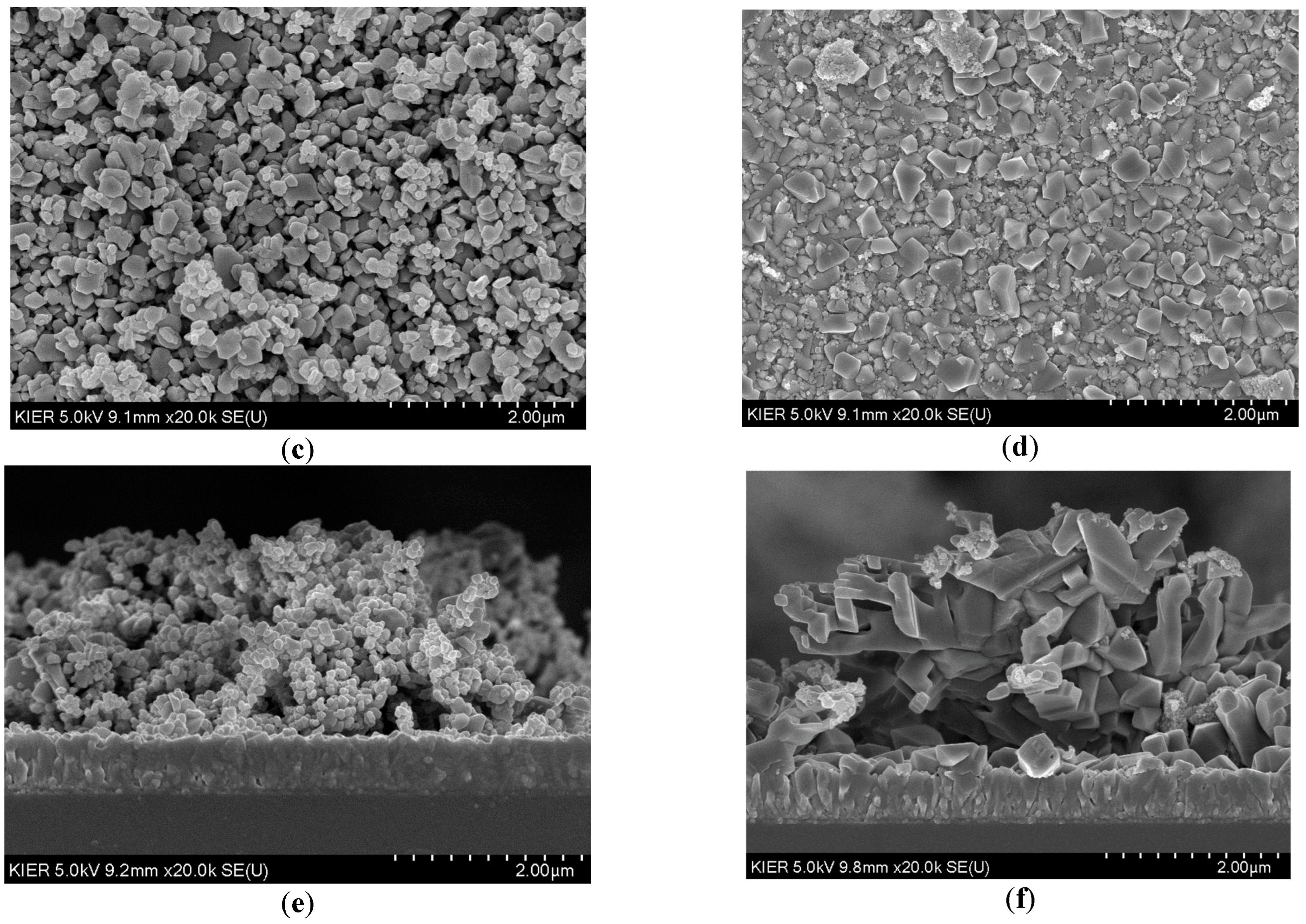
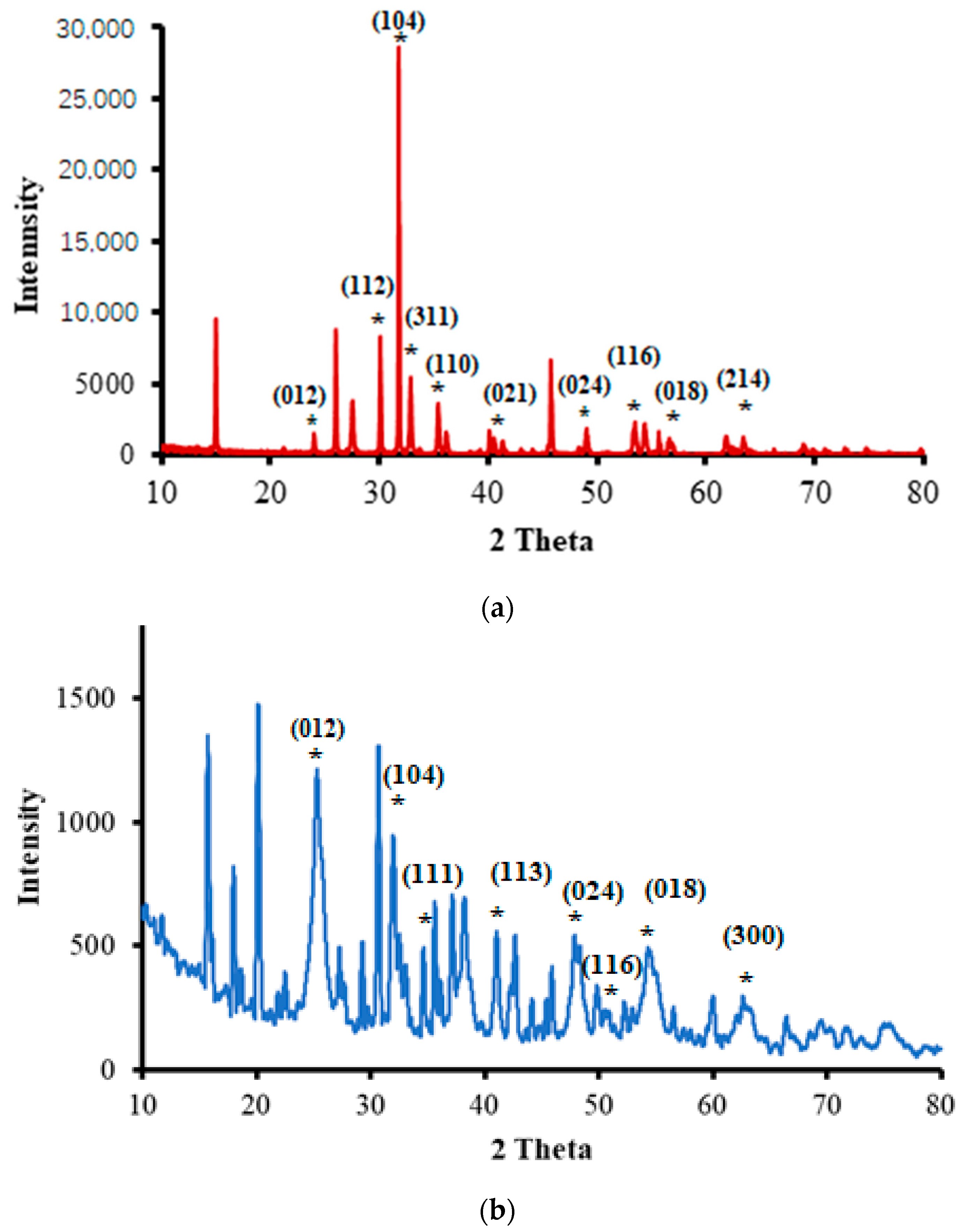
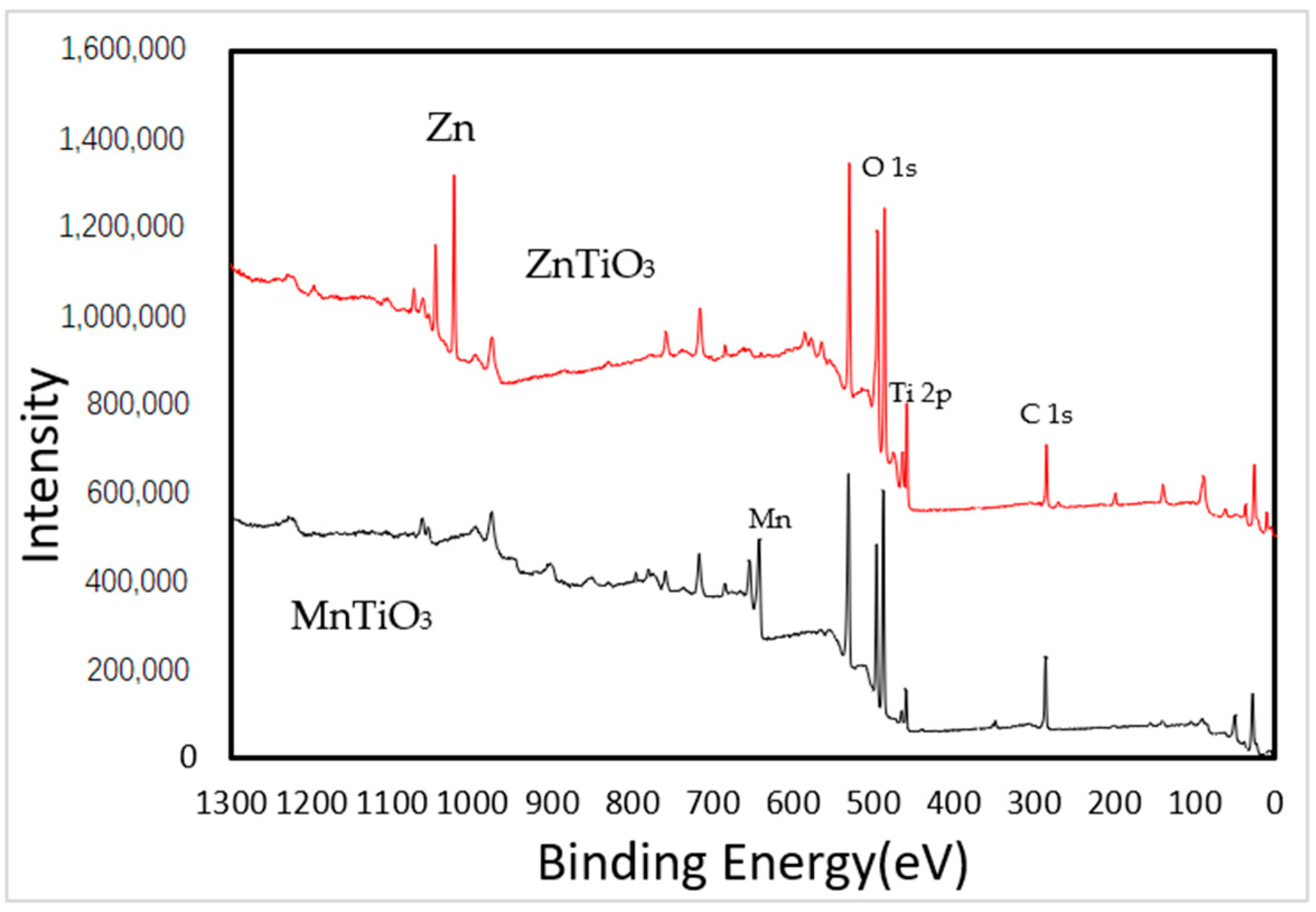
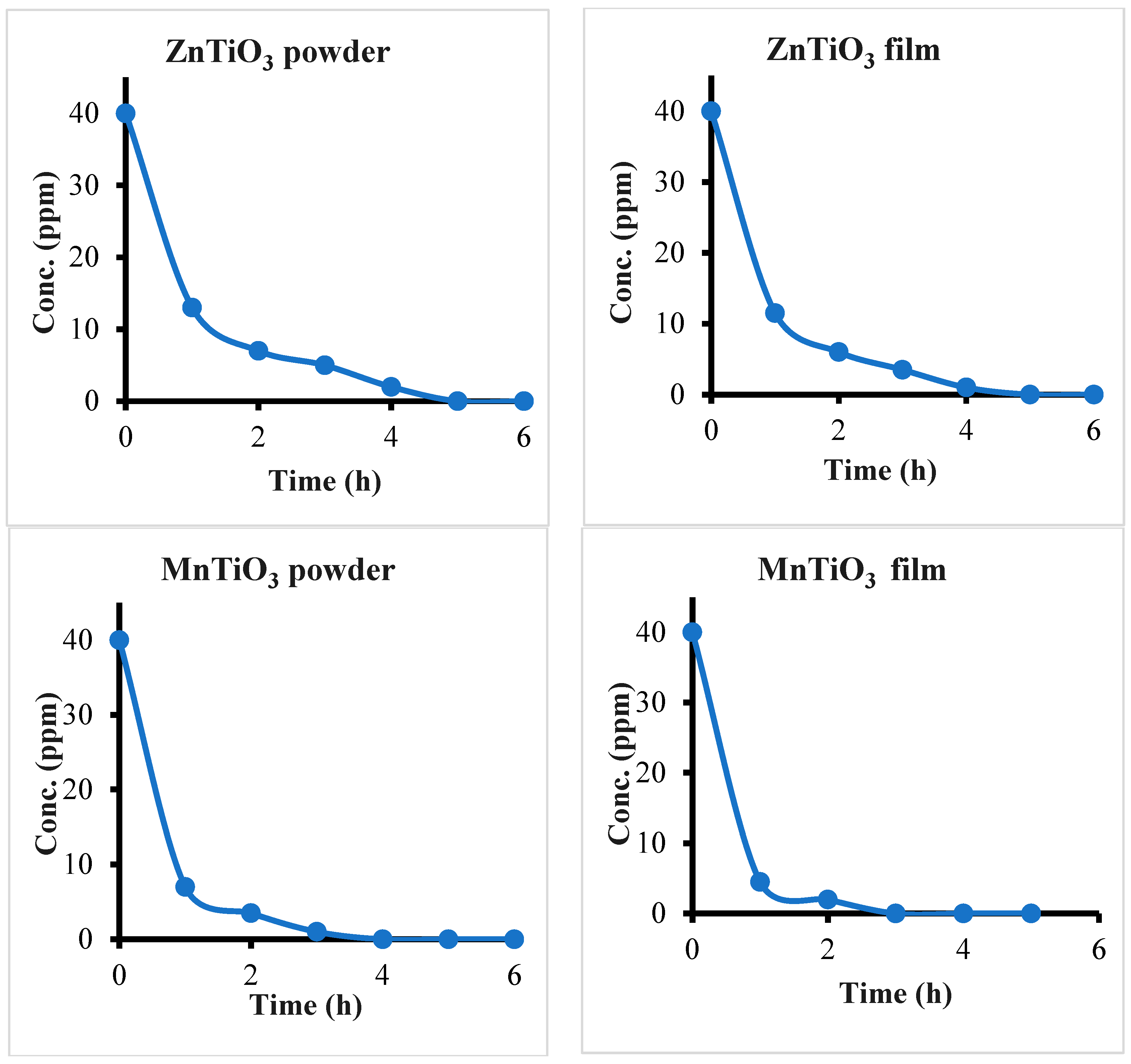
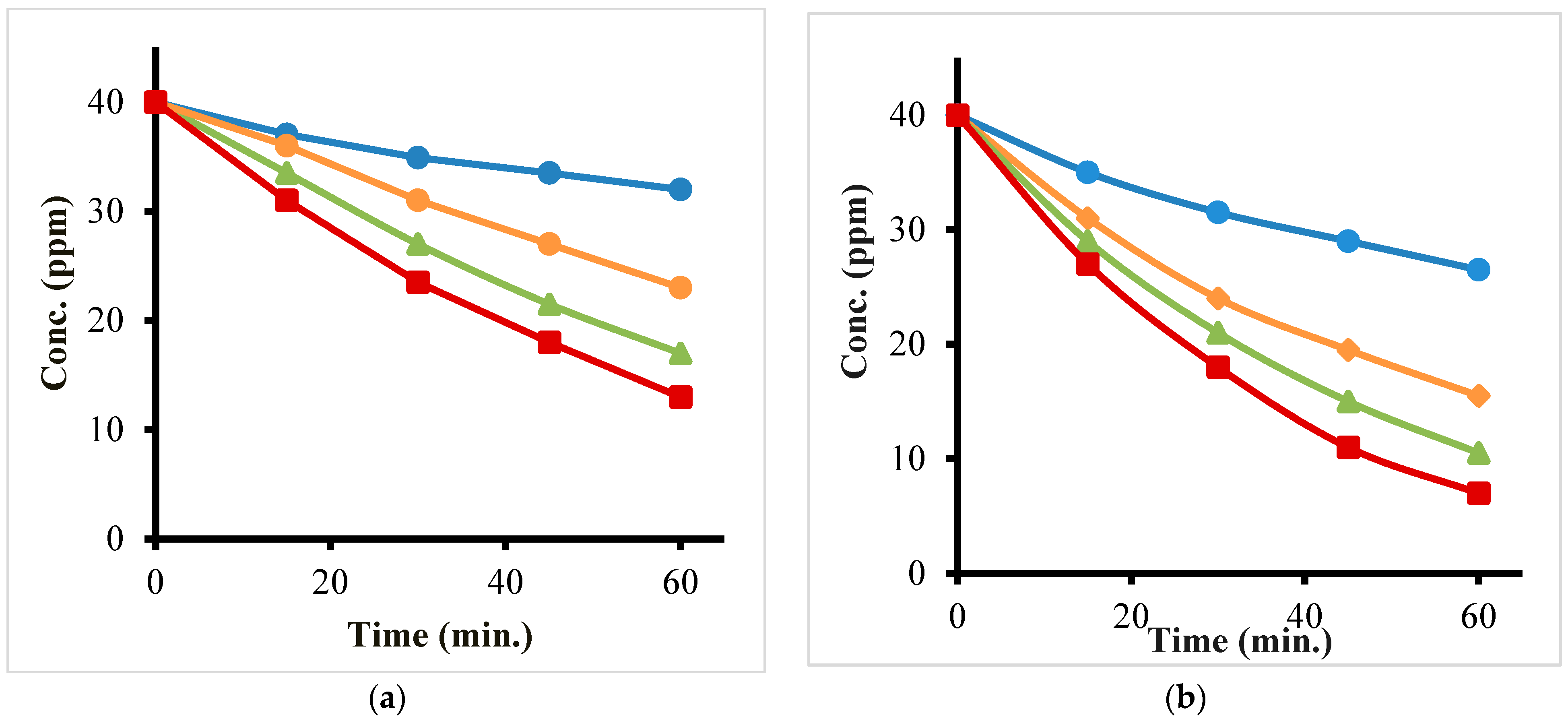




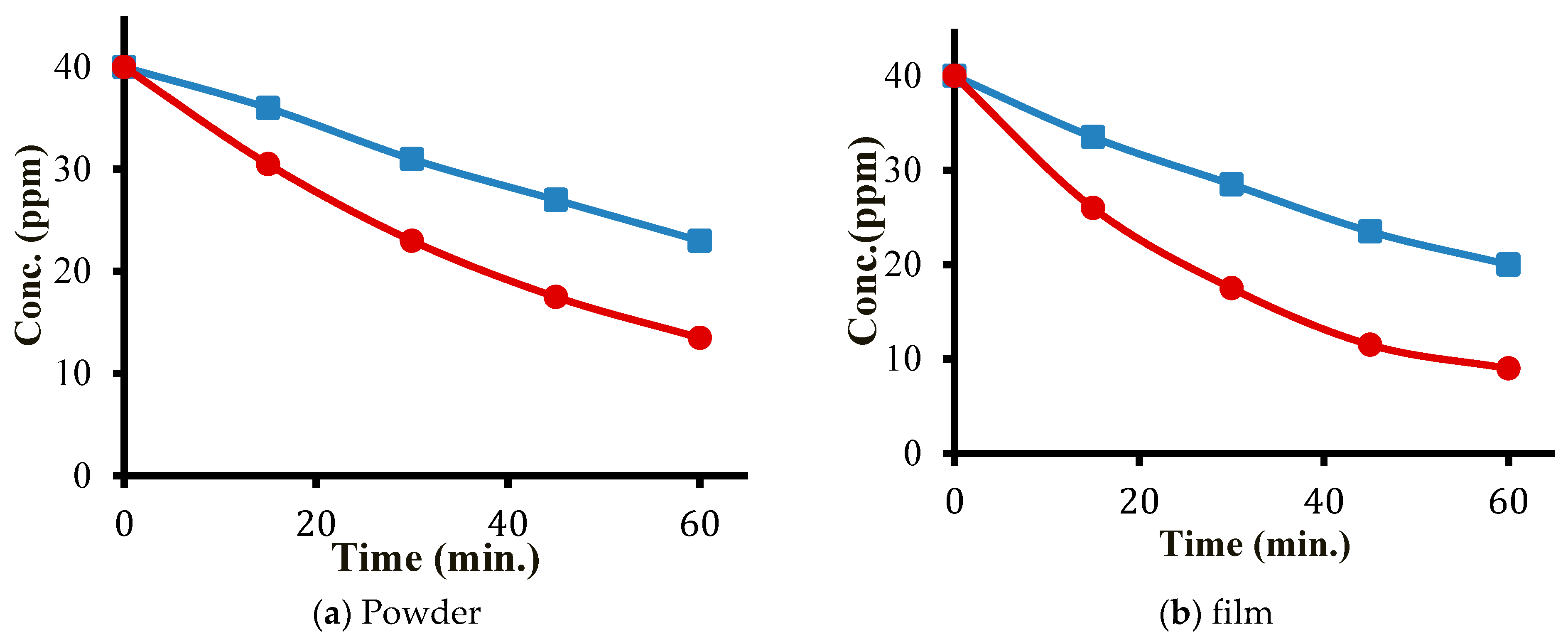
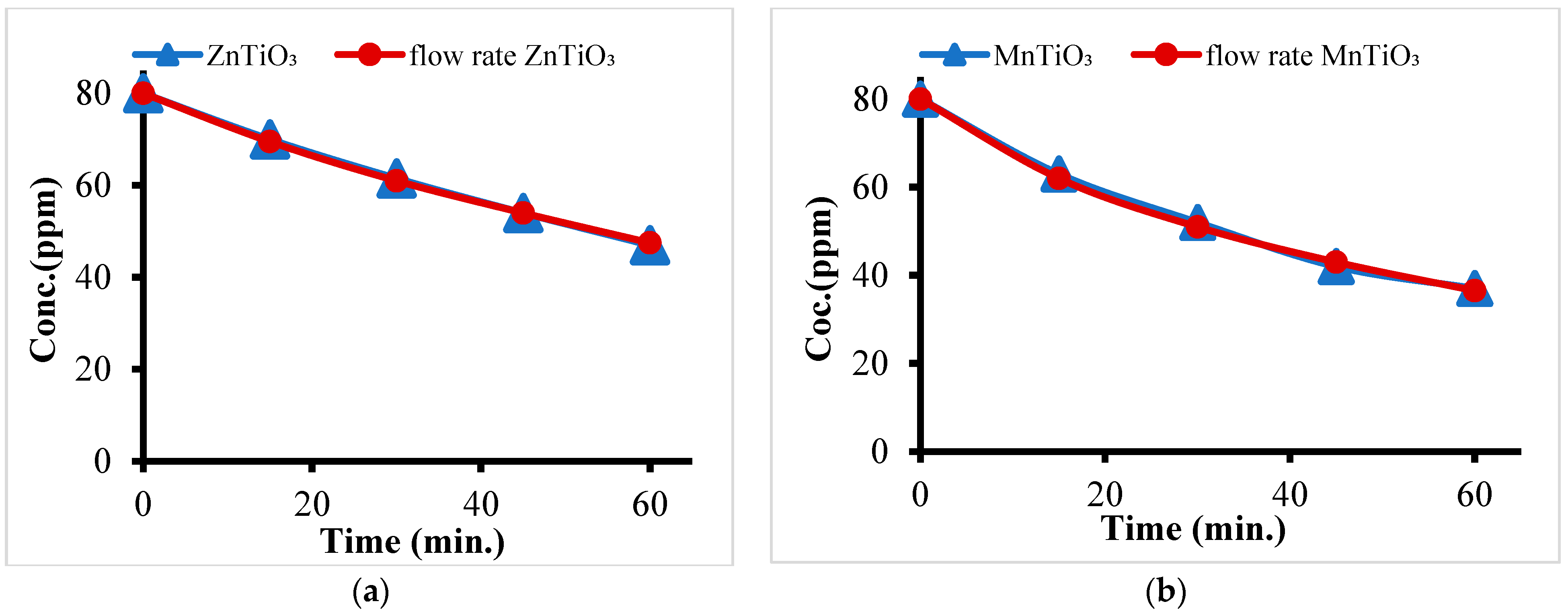
| Perovskite | Time (h) | Measured NO3− Ion (ppm) * |
|---|---|---|
| ZnTiO3 powder (0.1 g) | 5 | 3.32 |
| MnTiO3 powder (0.1 g) | 3.5 | 4.34 |
| ZnTiO3 film (monolayer, 2.3 × 10−3 g) | 4.5 | 3.40 |
| MnTiO3 film (monolayer, 1.8 × 10−3 g) | 3 | 4.50 |
| (a) | ||||||
|---|---|---|---|---|---|---|
| Catalyst | MB (ppm) | Degradation% | Conc. Loss (ppm) | T.N. (×10−6) | T.F. (×108) | Q.Y.(×1027) |
| ZnTiO3 powder (0.1 g) | 5 | 100 | 5 | 0.78 | 1.30 | 0.84 |
| 10 | 100 | 10 | 1.56 | 2.60 | 1.67 | |
| 20 | 55 | 11 | 1.72 | 2.87 | 1.84 | |
| 40 | 443 | 17 | 2.65 | 4.42 | 2.84 | |
| 60 | 40 | 24 | 3.74 | 6.23 | 4.00 | |
| 80 | 36 | 29 | 4.45 | 7.42 | 4.76 | |
| MnTiO3 powder (0.1 g) | 5 | 100 | 5 | 0.78 | 1.30 | 0.84 |
| 10 | 100 | 10 | 1.56 | 2.60 | 1.67 | |
| 20 | 75 | 15 | 2.34 | 3.90 | 2.50 | |
| 40 | 66 | 27 | 4.13 | 6.88 | 4.42 | |
| 60 | 57 | 34 | 5.30 | 8.83 | 5.67 | |
| 80 | 49 | 39 | 6.08 | 10.13 | 6.50 | |
| (b) | ||||||
| Catalyst | MB (ppm) | Degradation% | Conc. Loss (ppm) | T.N.(×103) * | T.F.(×105) ** | Q.Y. (×1025) *** |
| ZnTiO3 (2.3 × 10−3 g) | 5 | 100 | 5 | 0.34 | 0.57 | 3.64 |
| 10 | 100 | 10 | 0.68 | 1.13 | 7.28 | |
| 20 | 63 | 13 | 0.85 | 1.42 | 9.10 | |
| 40 | 50 | 20 | 1.36 | 2.27 | 14.55 | |
| 60 | 47 | 28 | 1.90 | 3.17 | 20.33 | |
| 80 | 39 | 32 | 2.14 | 3.57 | 28.90 | |
| MnTiO3 (1.8 × 10−3 g) | 100 | 5 | 0.43 | 0.72 | 4.60 | 4.60 |
| 5 | 100 | 5 | 0.43 | 0.72 | 4.60 | |
| 10 | 100 | 10 | 0.87 | 1.45 | 9.31 | |
| 20 | 83 | 17 | 1.43 | 2.38 | 15.30 | |
| 40 | 78 | 31 | 2.69 | 4.48 | 28.78 | |
| 60 | 65 | 39 | 3.38 | 5.64 | 36.17 | |
| 80 | 54 | 43 | 3.73 | 6.21 | 40.00 | |
Disclaimer/Publisher’s Note: The statements, opinions and data contained in all publications are solely those of the individual author(s) and contributor(s) and not of MDPI and/or the editor(s). MDPI and/or the editor(s) disclaim responsibility for any injury to people or property resulting from any ideas, methods, instructions or products referred to in the content. |
© 2023 by the authors. Licensee MDPI, Basel, Switzerland. This article is an open access article distributed under the terms and conditions of the Creative Commons Attribution (CC BY) license (https://creativecommons.org/licenses/by/4.0/).
Share and Cite
Zorba, T.; Nassar, H.; Helal, M.H.S.; Song, J.; Kim, T.W.; Jodeh, S.; Hilal, H.S. Perovskite Nano-Powder and Nano-Film Catalysts in Mineralization of Aqueous Organic Contaminants through Solar Simulated Radiation. Processes 2023, 11, 2378. https://doi.org/10.3390/pr11082378
Zorba T, Nassar H, Helal MHS, Song J, Kim TW, Jodeh S, Hilal HS. Perovskite Nano-Powder and Nano-Film Catalysts in Mineralization of Aqueous Organic Contaminants through Solar Simulated Radiation. Processes. 2023; 11(8):2378. https://doi.org/10.3390/pr11082378
Chicago/Turabian StyleZorba, Tamara, Heba Nassar, Muath H. S. Helal, Jeheon Song, Tae Woo Kim, Shehdeh Jodeh, and Hikmat S. Hilal. 2023. "Perovskite Nano-Powder and Nano-Film Catalysts in Mineralization of Aqueous Organic Contaminants through Solar Simulated Radiation" Processes 11, no. 8: 2378. https://doi.org/10.3390/pr11082378
APA StyleZorba, T., Nassar, H., Helal, M. H. S., Song, J., Kim, T. W., Jodeh, S., & Hilal, H. S. (2023). Perovskite Nano-Powder and Nano-Film Catalysts in Mineralization of Aqueous Organic Contaminants through Solar Simulated Radiation. Processes, 11(8), 2378. https://doi.org/10.3390/pr11082378







